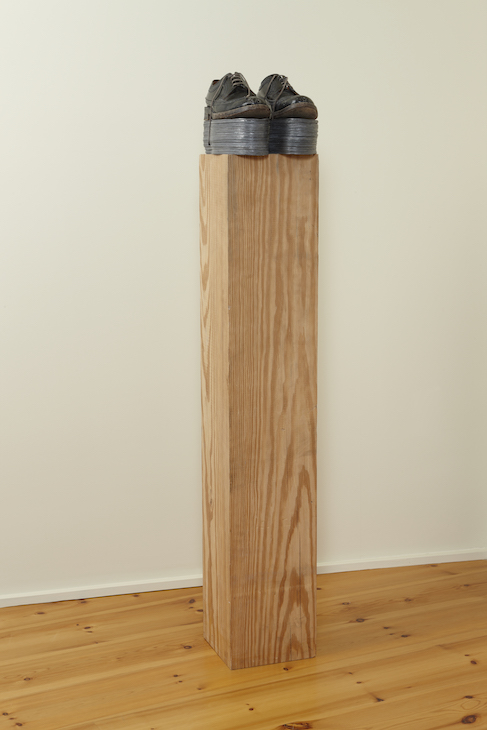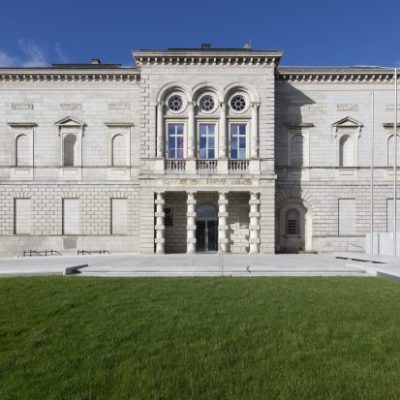Let me make this clear,’ says Giorgio Spanu, ‘our first mission is teaching, teaching and more teaching.’ Spanu’s wife, Nancy Olnick, continues, ‘We’re more interested in giving than owning.’ Spanu bats the conversation back, ‘As we learn about art we educate ourselves, then it’s a pleasure to share, to educate others.’ Olnick again: ‘Magazzino will be free, we shall use any donations to bring art to inner cities.’
Such repartee has been a feature of the sunny afternoon that I have spent with the couple around the dining table in their hilltop home. From its glass-encased living space, the 360-degree views encompass the still-leafless wood, spring flowers amid vestiges of winter snow, and sweeping views across the Hudson Valley. Conversation about their two collections of Italian art has stayed more or less on track. They have talked about their encounter with 20th-century Murano glass – of which they have assembled and published some 500 pieces – and they have explained their more recent commitment to the Arte Povera movement. Works from their post-war and contemporary Italian holdings, including many Arte Povera pieces, will go on public view from 28 June in their private exhibition space Magazzino Italian Art, a converted dairy distribution building at nearby Cold Spring in New York state.
The Olnick Spanu house in the Hudson Valley, New York, designed by Alberto Campo Baeza and constructed in 2008. Photo: Javier Callejas

Olnick and Spanu operate as one. They are contagiously enthusiastic about their art collecting and their wider mission. They don’t just play verbal shuttlecock; they frequently finish each other’s sentences. Spanu again: ‘Magazzino is not a foundation, not a not-for-profit; we fund it.’ Olnick: ‘With public arts support being cut so much, anything that can help with arts education is paramount to us.’ Often, they talk about their artistic discoveries simultaneously so it can be difficult to grasp one anecdote in full without missing a key moment in another. They have an urgency to get on, to do more. Yet they are meticulous about every detail of their collecting, research and publications.
The glass buying began by serendipity in the early 1990s, when a green and blue hourglass designed by Paolo Venini in 1955 caught their eye at a Sotheby’s viewing. They left a bid and got the piece. As Olnick, daughter of the late New York real-estate developer Robert S. Olnick, recalls: ‘I’d been buying Pop art: Warhol, Wesselmann, Oldenburg. We were at that time living high up in a building which was all windows. I put it in front of a small Warhol. It resonated so beautifully with all the light. I scoured the Lower East Side stores, found pieces from the 1950s and started to fill the window ledges.’ As there was little published about the glass, she ‘went on instinct’. Spanu picks up the story. On a flight to Italy, they spotted an advertisement for a show of 20th-century Murano glass in Venice. ‘On arrival in Milan, we rented a car and went directly to the Querini Stampalia.’ They also met Marino and Marina Barovier, champions of 20th-century Venetian glass, who would take them to Murano where they met Archimede Seguso and other glassmakers. It marked the start of what Olnick calls ‘our formal education’. It also kicked off their annual Venice sojourns: ‘We became immersed in local culture.’
Fenicio vase (1929), Carlo Scarpa for Maestri Vetrai Muranesi Cappellin & Co. Photo: Luca Vignelli

Carlo Scarpa became especially important to Olnick. ‘I particularly love the lattimi series, so light, like eggshell, made when he was with Cappellin, before he went to Venini.’ As she writes on the couple’s website, ‘The simplicity of his forms, his Eastern influences, and his novel glassmaking techniques brought a modernism to Murano that it had never before seen. His work became the ultimate focus of our collection.’ In 2000, their glass collection filled two floors of New York’s American Craft Museum (now called the Museum of Arts and Design), introducing 20th-century Murano glass to the US. ‘The whole design world turned out for the opening,’ Spanu recalls. ‘Just thinking about it gives me butterflies 17 years later.’ The exhibition’s success led to a national tour that included leading institutions in Houston, Nashville and Detroit. ‘When we went to see it in Detroit,’ remembers Spanu, ‘they did a fantastic programme for children about how Murano glass was made.’ ‘It made us understand how important that kind of education is,’ adds Olnick.
At the moment the couple have a dedicated display of Carlo Scarpa’s works on view in the library of their New York apartment. ‘The lighting is very difficult,’ says Spanu, ‘but finally we changed to LED and the result is astonishing’. ‘We are very sensitive to our surroundings,’ adds Olnick unassumingly. ‘Everything has to harmonise, and it goes down to our clothes, garden, food. It runs from A to Z.’ Any museum would be impressed at the way Olnick and Spanu have put their Murano collection – hand-blown glassworks made between 1910 and the present – on their website with fully researched documentation of the pieces, artists and workshops.
As their collecting deepened, Olnick and Spanu built on their naturally discerning eyes. Olnick grew up surrounded by art and inherited her mother’s keen aesthetic: ‘It’s a gut instinct I have always had, and when I see something I like then I want to know more’. Spanu’s upbringing was very different. ‘I come from Sardinia. My mother and grandmother were weavers. They used to make baskets of all sizes, from five centimetres to very big – for weddings, drying vegetables, everything.’ When living in Florence, ‘which is a gigantic museum itself’, he encountered Renaissance art and earned money by taking tourists around – ‘I had them for their three hours in Florence!’ He remembers going to a Paul Klee exhibition several times. ‘I was mesmerised, though believe me, I love Piero della Francesca too!’ Despite their different backgrounds, Olnick insists that ‘we have very much the same aesthetic and can buy on our own’. ‘If I see something, it’s easy now, I can take a photo and send it. In those days, I would put a piece on hold. There’s not one piece that either of us has any reservation about.’
Jug and glasses for Ciga (1979), Massimo Vignelli for Venini & Co. Photo: Elizabeth Lamark

Nevertheless, they value their mentors, perhaps none more so than Massimo Vignelli – designer of the New York Subway maps and author of the seminal design book Vignelli From A to Z. ‘He and his wife Lella have been so important to our lives,’ Spanu says. ‘His first job had been for Venini designing glass.’ Here Spanu nips off to fetch a book, flipping through it to find the illustration he’s seeking. ‘When we met him for the first time, in his stunningly beautiful office on 10th Avenue, we already had one of his pieces in our collection. Look, this piece – Venini workshop, 1979. You are drinking out of this glass.’ It’s true: Vignelli’s water jug and glass sit on the table beside me. ‘That was the beginning, says Spanu, who credits Vignelli with finding the Spanish architect Alberto Campo Baeza, who built their house (‘We visited all his buildings in Spain before we commissioned it’).
The house itself is the location for the couple’s Art Program, an annual commission given to an Italian artist to create a site-specific work on their estate. Inspired by Giorgio Vigna, who was the first artist they commissioned in 2003, the Program encourages artists to work with ‘the memory’ of Italy’s Arte Povera movement. The project continued most recently in 2014–15 with Paolo Canevari. Olnick also sees this as a continuation of what the 19th-century Hudson Valley patrons and painters were doing in the area.
Installation view of Panchina (2008–09) by Domenico Bianchi, commissioned for the 2009 Olnick Spanu Art Program. Photo: Marco Anelli

It was while they were collecting glass and developing their interest in Italian contemporary art that Olnick and Spanu fell upon what would become their second focus. Their friend, the late Sauro Bocchi, a gallerist based in Rome, encouraged them to visit the museum of contemporary art in the Castello di Rivoli, Turin. While there, they encountered the Arte Povera works in the museum’s permanent collection. Arte Povera (‘poor art’) was a radical movement born in late 1960s Italy, formed by loosely connected artists living mainly in Turin and Rome. As a comment on the commercialism of art in both these cities, the artists involved used cheap, everyday materials, and borrowed ideas from conceptual and minimalist art practices. Bocchi later lent works to an exhibition at the Palazzo delle Papesse in Siena, organised by Sergio Risaliti. ‘We went right away. We were blown away by every piece,’ remembers Spanu. ‘Some works later came to market. We bought Giulio Paolini’s Il Cielo e dintorni from Sauro Bocchi. We installed it on our property here – it’s a great inspiration.’
Olnick is especially captivated by the Arte Povera ideals. ‘This is not a group who had a common manifesto,’ she explains. ‘They were individuals, very avant-garde and revolutionary in terms of breaking traditions and reacting to the politics of the late 1960s – Vietnam and, in Italy, over-industrialisation so the artisanal was being lost. They went back to nature, exploring gravity, how nature evolves, spirituality, nomadic life.’ She cites the oldest member of the movement, Mario Merz, whose Igloo (From Continent to Continent) (1993) will be on show at Magazzino. This interest in craft informed her and Spanu’s decision to commission L’anello degli Appalachi by Mario Airò for their 2007–08 Art Program, which was made by ‘one hundred percent local craftsmen and materials’. With Domenico Bianchi’s commission the following year, Panchina, Olnick likes him ‘referring to Bernini by inlaying very precious marble into a poor man’s cheap marble, pietra cardosa’. She reflects for a moment. ‘There is a juxtaposition between historic and modern, cheap and expensive materials. That’s what we like.’
Untitled (1989), Jannis Kounellis

Olnick and Spanu’s collection grew. The pieces, often big, are unsuited to a house with glass walls. ‘We had the idea of making a place for our art on the property,’ says Giorgio, ‘but it did not go down well with the community. So, we bought the dairy processing building.’ As Miguel Quismondo, the architect of its conversion into Magazzino, says, ‘it is more than good, it is perfect. The simple module of the building was so good we can just preserve it, and build on it.’ The L-shaped building allows for versatile lighting, and its big windows overlook grounds which will, of course, be meticulously landscaped. Visitors enter through a glazed lobby that leads to the galleries and a central courtyard, where events and performances will lure in the wider community.
The plan is for major installations selected by Olnick and Spanu from their collection, plus new acquisitions and commissions, to be in place for several years. Magazzino’s director, Vittorio Calabrese, believes that ‘Nancy and Giorgio are pioneers in collecting Italian post-war art and introducing it to the US’. Calabrese also takes care of the collection’s loans, research, and the continuing Art Program, which will move to Magazzino. The first show has about 70 works spanning two generations of artists and it will pay homage to Margherita Stein, who promoted the Arte Povera movement at her Turin gallery, Christian Stein, from 1966 to 1999. ‘She took her husband’s name to give her credibility,’ Spanu explains. Many of the artists Stein promoted are now represented in the Olnick Spanu collection.
Consistent with Olnick Spanu’s focus on education, Magazzino incorporates an art library housing a collection of about 5,000 books and archival material acquired with the help of art historian Giorgio Mastinu. ‘By this autumn, the full catalogue will go on line with WorldCat, the world’s largest library catalogue,’ enthuses Calabrese, ‘as an opportunity for any level of research.’ The intention is to translate many of the books, which are in Italian, into English to improve public understanding of the conceptual frameworks of the collection.
Basta la vista (1988), Luciano Fabro. Photo: Ron Amstulz

The need for the library was endorsed when Massimo Bartolini, an artist from Cecina, Italy, was teaching at the University of Pennsylvania and asked Spanu if he could bring some students to see the collection. ‘It is one of the best places to study art history, yet neither the students nor the faculty had heard of Arte Povera,’ says Spanu with incredulity. ‘We expected him to arrive with six students but he came with a full coach.’ Bartolini gave part of his lesson in front of Luciano Fabro’s Basta la vista (1988), which at that time hung in the pool house but has now been moved to Magazzino.
‘What is so interesting about the Arte Povera artists we are presenting at Magazzino,’ muses Spanu, ‘is that they never lost sight of the Italian historical art they grew up with. Luciano Fabro, Giulio Paolini, Jannis Kounellis.’ He gestures to a short piece of unattached wall in their glass eyrie, which Olnick explains: ‘This piece behind you, by Kounellis, uses numbers, arrows, street signs – as did Jasper Johns and Rauschenberg. Let me tell you, they went to Italy. I don’t know which came first. Chicken and egg.’ ‘Then,’ Spanu says, reverting to his theme, ‘there were Alberto Burri, Piero Manzoni, Lucio Fontana. And I’d also include Fausto Melotti – you saw the big piece by him as you came into the property. He studied at Brera with the Symbolist sculptor Adolfo Wildt, and met Fontana there.’
Now Olnick points to another piece of unattached wall, where a framed cluster of white and brightly-coloured pieces of cloth dangle. ‘This will be at the front of Magazzino. It’s by Michelangelo Pistoletto.’ Spanu explains: ‘It’s called Stracci Italiani (‘Italian rags’, 2007), to infer that poor Italy is always in rags.’ ‘It’s about over-reliance on technology in a country where the artisan is paramount. Arte Povera was a specifically Italian reaction,’ Olnick continues. For Olnick, some works are easier to let go from the house than others. As if trying to convince herself, she firmly points out that several pieces by Alighiero Boetti which currently hang on the bedroom walls, including Lasciare il certo per l’incerto e viceversa (1983), will go to Magazzino. Moments later she qualifies this: ‘I might change one or two as it goes along, I’m not sure.’
Lasciare il certo per l’incerto e viceversa (1983) by Alighiero Boetti hangs on a bedroom wall. Photo: Dina Kantor

Spanu is not concerned about Magazzino’s visitor numbers. ‘Georges-Henri Rivière, the father of modern museum theory, said that the number of visitors you draw is not important. Much more important is to teach something to those who come, so they have something to take away.’ Nevertheless, a visit to Magazzino neatly dovetails with the area’s other attractions. Moments away, the Russel Wright Design Center at Manitoga celebrates one of America’s leading industrial designers, while the Federal-style Boscobel House is the setting for a 19th-century furniture collection. Dia:Beacon is just up the river and, on the other bank, rolling hills are dotted with the monumental sculptures of Storm King Art Center – ‘Peter Stern did that for the love of art, for giving back – he thought like us.’
‘We dare to help Italian artists, as well as American artists with ties to Italy, be better known here,’ concludes Spanu. ‘The Arte Povera artists will always be contemporary, be relevant, be timeless and fresh,’ Olnick adds. Spanu looks across the table to his wife, then says: ‘We want visitors to Magazzino to take advantage of our luck. We tell each other how lucky we are every day.’
Magazzino Italian Art opens on 28 June in the Hudson Valley, New York.


